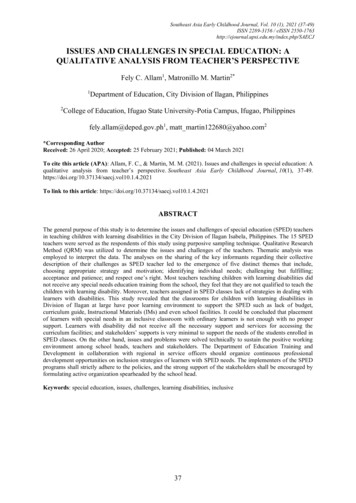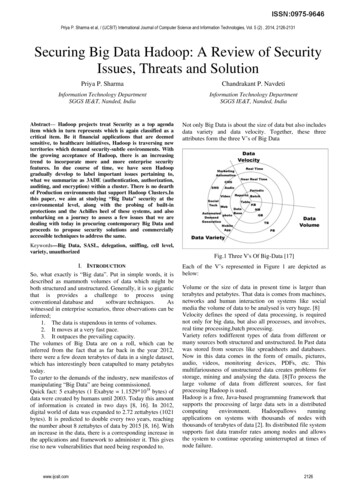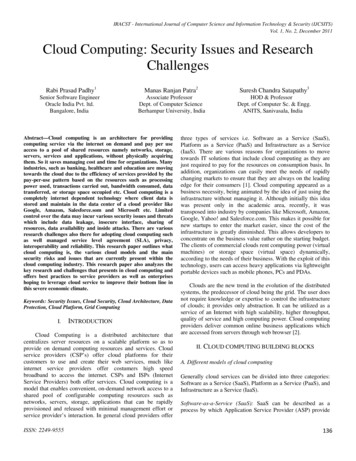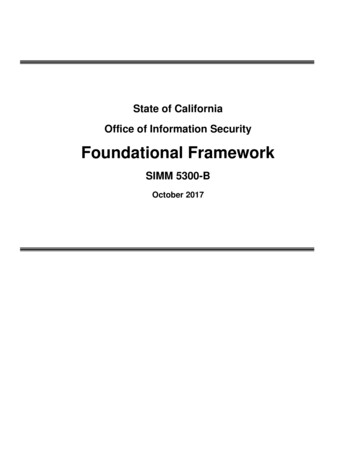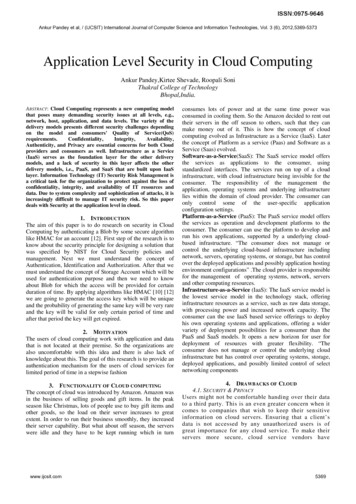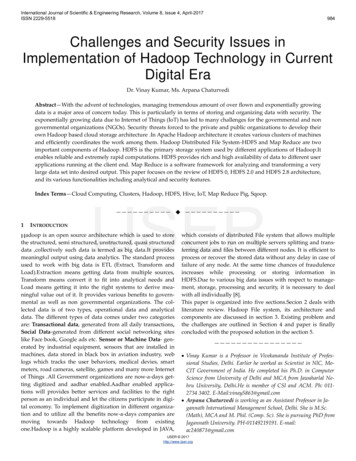
Transcription
International Journal of Scientific & Engineering Research, Volume 8, Issue 4, April-2017ISSN 2229-5518984Challenges and Security Issues inImplementation of Hadoop Technology in CurrentDigital EraDr. Vinay Kumar, Ms. Arpana ChaturvediAbstract—With the advent of technologies, managing tremendous amount of over flown and exponentially growingdata is a major area of concern today. This is particularly in terms of storing and organizing data with security. Theexponentially growing data due to Internet of Things (IoT) has led to many challenges for the governmental and nongovernmental organizations (NGOs). Security threats forced to the private and public organizations to develop theirown Hadoop based cloud storage architecture .In Apache Hadoop architecture it creates various clusters of machinesand efficiently coordinates the work among them. Hadoop Distributed File System-HDFS and Map Reduce are twoimportant components of Hadoop. HDFS is the primary storage system used by different applications of Hadoop.Itenables reliable and extremely rapid computations. HDFS provides rich and high availability of data to different userapplications running at the client end. Map Reduce is a software framework for analyzing and transforming a verylarge data set into desired output. This paper focuses on the review of HDFS 0, HDFS 2.0 and HDFS 2.8 architecture,and its various functionalities including analytical and security features.IJSERIndex Terms—Cloud Computing, Clusters, Hadoop, HDFS, Hive, IoT, Map Reduce Pig, Sqoop.—————————— ——————————1INTRODUCTIONHadoop is an open source architecture which is used to storethe structured, semi structured, unstructured, quasi structureddata ,collectively such data is termed as big data.It providesmeaningful output using data analytics. The standard processused to work with big data is ETL (Extract, Transform andLoad).Extraction means getting data from multiple sources,Transform means convert it to fit into analytical needs andLoad means getting it into the right systems to derive meaningful value out of it. It provides various benefits to governmental as well as non governmental organizations. The collected data is of two types, operational data and analyticaldata. The different types of data comes under two categoriesare: Transactional data, generated from all daily transactions,Social Data-generated from different social networking siteslike Face book, Google ads etc. Sensor or Machine Data- generated by industrial equipment, sensors that are installed inmachines, data stored in black box in aviation industry, weblogs which tracks the user behaviors, medical devies, smartmeters, road cameras, satellite, games and many more Internetof Things .All Government organizations are now-a-days getting digitized and aadhar enabled.Aadhar enabled applications will provides better services and facilities to the rightperson as an individual and let the citizens participate in digital economy. To implement digitization in different organization and to utilize all the benefits now-a-days companies aremoving towards Hadoop technology from existingone.Hadoop is a highly scalable platform developed in JAVA,which consists of distributed File system that allows multipleconcurrent jobs to run on multiple servers splitting and transferring data and files between different nodes. It is efficient toprocess or recover the stored data without any delay in case offailure of any node. At the same time chances of fraudulenceincreases while processing or storing information inHDFS.Due to various big data issues with respect to management, storage, processing and security, it is necessary to dealwith all individually [8].This paper is organized into five sections.Secion 2 deals withliterature review. Hadoop File system, its architecture andcomponents are discussed in section 3. Existing problem andthe challenges are outlined in Section 4 and paper is finallyconcluded with the proposed solution in the section 5.———————————————— Vinay Kumar is a Professor in Vivekananda Institute of Professional Studies, Delhi. Earlier he worked as Scientist in NlC, MoCIT Government of India. He completed his Ph.D. in ComputerScience from University of Delhi and MCA from Jawaharlal Nehru University, Delhi.He is member of CSI and ACM. Ph: 0112734 3402. E-Mail:vinay5861@gmail.com Arpana Chaturvedi is working as an Assistant Professor in Jagannath International Management School, Delhi. She is M.Sc.(Math), MCA and M. Phil. (Comp. Sc). She is pursuing PhD fromJagannath University. PH-01149219191. E-mail:ac240871@gmail.comIJSER 2017http://www.ijser.org
International Journal of Scientific & Engineering Research, Volume 8, Issue 4, April-2017ISSN 2229-55182 REVIEW AND EXISTING PROBLEM2.1 Lierature ReviewJ.Zhao, L.Wang, J Tao, J. Chen, W. Sun, R. Ranjan has suggested that Map Reduce is viewed as the appropriate programming model for extensive scaled information based applications [1]. Hadoop based system uses map reduce programming to run on different clusters.G-hadoop reuses theclient validation and occupation accommodation system ofHadoop, which is intended for the solitary group. They proposed security model for Hadoop which depends upon opencryptography and SSL convention. This security structureopens up the client’s confirmation and employment accommodation procedure of the present G-Hadoop execution witha solitary sign-on methodology [2].V. Kadre, Sushil Chaturvedi proposed AES-MR encryption scheme for securing Data inHDFS Environment .The AES encryption algorithm is one ofthe best approaches to encode data. It works in parallel. Theybroadly utilized IEEE 1619-2007 standard XES-TCB-CTS(XTS)mode in which key material for XTS-AES comprises of encryption key. The XTS mode permits parallelization and pipelining which empowers the last deficient piece of data.[3]Monika Kumari, Dr. Sanjay Tyagi suggested threelayered security model for data management in Hadoop environment. In this approach a secure tunnel based transmissionis provided for communication with authenticated users. Onetime authentication is provided by RSA algorithm, SSL layeris activated to avail Hadoop services. For free users RSAbased authentication is performed to allow public area access.The security is implemented in the middle layer which is divided into 3 parts, Authentication, Secure Session and SecureData management. [3]Rajesh Laxman Gaikwad,Prof. Dhananjay M Dakhane ,Prof Ravindra L Paridhi has proposed Network security enhancement in Hadoop Clusters by introducing automation in authentication using Delegation tokens andsuggested advanced security models in the form of SecurityEnhancement and security using Role Based Access Controlwith discussion about developments in Web authenticationsfor Internet-based users of Hadoop Clusters.985lated issues like misuse of personal data and fraudulent issues. At the time of Hadoop implementation one should ensure that the security features should be implemented in sucheffective way that only authenticate user should be able touse data, no case of fraudulent or misuse of informationshould arise.Challenges of Hadoop:It has many challenges which are to be overcome so that allorganization can rely on it and store ever-growing data into itwith reliability and security. At present it has following challenges:1)Constant growth in data: As the data is ever growing andexponential, the Hadoop clusters are also need to bescaled. Its ecosystem consists of complex set of software,which keeps on changing as per the demand and necessity in maintaining datasets. The existing scenario has lackof protocols or guidance which can provide the best platform to run it safely.No fix Platform to work on: The Hadoop Community isnot having a fixed platform; it depends upon the end user to choose as per the requirement. At the same time enduser may not have appropriate knowledge of hardwareto provide the best possible solution of the problem.IJSER2.2 Problem to be discussed in this paperAll existing and growing private and government organization are adopting Hadoop based cloud storage architecture.All crucial and personal data will be lying in the storage architecture of Hadoop. It keeps sensitive information in multiple nodes, clusters or servers in the form of separate files. Ituses so many technologies Hive, Pig, HBase, and Mahout toanalyze data more efficiently and effectively. Most of the private and government organizations have fear in keeping theirdata in Hadoop [13].Hadoop has no Security feature implemented by default, which later on arise so many security re-2)In 2010 The Economist asserted that data has become a factorof production, almost on par with labor and capital.IDC predicts that the digital universe will be 44 times bigger in 2020than it was in 2009, totaling a staggering 35 zettabytes. EMCreports that the number of customers storing a petabyte ormore of data will grow from 1,000 (reached in 2010) to 100,000before the end of the decade. By 2012 it expects that some customers will be storing Exabyte’s (1,000 petabytes) of information. In 2010 Gartner reported that enterprise data growth willbe 650 percent over the next five years, and that 80 percent ofthat will be unstructured.Hadoop Components and Architecture:Apache Hadoop software library can detects and handles failures at the application layer hence deliver high availabilityservices in the top of all multiple clusters of computers andmake individually each of them less error prone.Hadoop architecture consists of not only Hadoop componentsbut also an amalgamation of different technologies that provides immense capabilities in solving complex business problems, government projects.IJSER 2017http://www.ijser.org
International Journal of Scientific & Engineering Research, Volume 8, Issue 4, April-2017ISSN 2229-5518Hadoop 1.0Map Reduce(Cluster ResourceManagement andData ProcessingHDFSFie storagejar files, stored in Hadoop common to communicate with oraccess HDFS.Hadoop 2.0Map Reduce(DataProcessing)Others(Data Processing)YARN( Cluster Resource Management andData Processing)HDFS( File Storage)Fig. 1 Difference in Hadoop 1.0 and Hadoop 2.0On the basis of working of all the components of the Hadoopecosystem; it has been divided onto five levels. These are: 9862) Hadoop Distributed File System (HDFS) –The HDFS, default storage layer is based on Master-Slave architecture modelwhere the Name Node acts as the master node and Data Nodeacts as a Slave Node. The Master Node i.e. Name Node keepsthe track of the storage cluster and the Slave Node i.e. DataNode is responsible to sum up the various systems within aHadoop cluster.3) Map Reduce- Distributed Data Processing Framework ofApache HadoopJava based Hadoop’s Map Reduce is parallel processing system based on Yet Another Resource Negotiater (YARN) architecture. Map Reduce takes care of scheduling jobs, monitoringjobs and re-executes the failed task. The delegation tasks of theMap Reduce component are tackled by - Job Tracker and TaskTracker as shown in the image below –IJSERCore ComponentsData Access ComponentData integration ComponentData Storage ComponentMonitoring, Management and Orchestration ComponentsFig 3. Delegation task of Map Reduce ComponentFig 2. Components of HadoopCore Hadoop ComponentsThe Core Components of Apache Hadoop Ecosystem whichforms the basic distributed Hadoop framework are comprisesof 4 components Hadoop Common, HDFS, Map Reduce andYARN [4].1) Hadoop CommonIt consists of pre-defined set of utilities, libraries that are usedby other all modules exists within the Hadoop Ecosystem. ForE.g. HBase and Hive need to make Java archive (JAR) files i.e.4) YARNYet Another Resource Negotialter (YARN) introduced in Hadoop 2.0 is a dynamic resource allocator in the Hadoopframework as users can run various Hadoop applicationswithout having to bother about increasing workloads.2) Integration Components with Databases or Data AccessComponents used by Enterprises: The other data access components of Hadoop Ecosystem forms an integral part of Hadoop Ecosystem, enhances the strength of it as provide betterintegration with databases, makes Hadoop faster with newfeatures and functionalities. These eminent Hadoop components are Pig and Hive. Pig- Apache Pig provides optimized,IJSER 2017http://www.ijser.org
International Journal of Scientific & Engineering Research, Volume 8, Issue 4, April-2017ISSN 2229-5518extensible and easy to use high level data flow language PigLatin. It is developed by Yahoo for analysing voluminous datasets efficiently and easily. Hive-It uses HiveQL languagewhich is similar to SQL for querying and analysing the data. Itwas developed by Face book. It can summarize data from datawarehouse and makes query faster through indexing.Data Integration Components of Hadoop Ecosystem- Sqoopand FlumeSqoop: It is used for import and export purpose both. It imports the data from external sources into related It also exportsdata from Hadoop to other external structured data stores. Itcopies data quickly, performs efficient and faster data analysisas can transfer data in parallel and also mitigates excessiveloads.Flume-It is used for collecting data from the source as gathersand aggregate voluminous data and stores it back to HDFS.Itcan perform it properly by outlining data flows which consistsof 3 primary structures channels, sources and sinks. Theprocesses that run the dataflow with flume are known asagents and the bits of data that flow via flume are known asevents.sector to perform big data analytics by implementing one ormore Hadoop components.Need of Hadoop:With the advent of technology and implementation of it in theform of digitization exploded the huge amount of structuredand unstructured data with the increasing volume day by day.It has increased the demand of high storage capacity, management of information, accessing it, analyzing it and the needof management of this data with security so that it can be analyzed and extracted without any loss of information. All theorganizations are moving the data on Hadoop architecturebecause of the following special features it has:1) Capability of storing and Processing Variety of ComplexDatasets in distributed Systems.2) Fast and Reliable parallel and multiple node Computational ability at the CPU cores.3) Fault Tolerance and High Availability, Ability to handlereal time node failures and redirecting to other nodes tohandle it at the application layer.4) Storing and retrieving enormous data at once withoutdata pre-process.5) Scalable in nature as able to increase in size from singlemachine to thousands of servers.6) Servers can be added or removed from the clusters dynamically without any interruption in operation.7) Cost effective as Hadoop is an open source technology.8) Compatible in all platforms as based on Java.IJSERData Storage Component of Hadoop Ecosystem –HBaseHBase –HBase is a column-oriented database that uses HDFS for underlying storage of data and helps NoSQL database enterprises to create large database with millions of rows and columns.It is best to use when random read and write access are required to access large datasets as it supports random readsand batch computations using Map Reduce.Monitoring, Management and Orchestration Components ofHadoop Ecosystem- Oozie and Zookeeper Oozie-It is a workflow scheduler that runs on java serveletscontainer Tomcat where the workflows are expressed as Directed Acyclic Graphs. It manages all Hadoop Jobs like Mapreduce,Sqoop,Hive and pig as stores all running workflowinstances, their states and variables in the database whichare executes on the basis of data and time dependencies. ZookeeperZookeeper works as coordinator as responsible for synchronization service, distributed configuration service and for providing a naming registry for distributed systems hence provides simple,fast,reliable and ordered operational service for aHadoop cluster.The other components of Hadoop Ecosystem –The other common components of Hadoop Ecosystem are:Avro, Cassandra, Chukwa, Mahout, HCatalog, Ambari andHama. The user can provide appropriate solution to the requirements of any business organization or to government987The Benefits of HDFS There is little debate that HDFS provides a number of benefits for those who choose to use it. Below are some of the most commonly Built-In Redundancy and Failover HDFS supplies out-ofthe-box redundancy and failover capabilities that requirelittle to no manual intervention (depending on the usecase). The hardware and infrastructure if not properly managed can run into the millions. This is where HDFScomes as a blessing since it can successfully run on cheapcommodity hardware. The characteristics that Big data comprise of data velocity, veracity, value, variety, and volume and its providing access to streaming data[11]. Portability any tenured data professional can relay horror stories of having to transfer, migrate, and converthuge data volumes between disparate storage/softwarevendors. Scalability is the biggest strength of HDFS as can storedata in much more than zeta bytes and retrieves easilyon demand Moving computation rather than data and providing extreme throughputIJSER 2017http://www.ijser.org
International Journal of Scientific & Engineering Research, Volume 8, Issue 4, April-2017ISSN 2229-5518988The Benefits of Map Reduce: Map Reduce is the data processing engine of Hadoop clusters deployed for Big Data applications. The basic framework of a Map Reduce program consistsof the two functions the Mapper and Reducer. These two pillars of Map Reduce can ensure that any developer can createprograms to process data that is stored in a distributed fileenvironment like HDFS [5].Fig 6. ProposedModel for security implementation in Big DataFig 5. Process of Data using Map ReduceIJSERThere are some distinct advantages of Map Reduce and wehave listed some of the most important below: Proposed Features to handle Big data Security Challenges:1) Sharing and Privacy: There are several different integration models. The idea for big data security analytics is to store more critical or sensitive data in cluster within a cluster using various available data mining technique.2) Data Encryption: This is an important feature tomake the big data more secured to access only withthe administrator access rights. It has recommendedFile/OS level encryption because it scales as you addnodes and is transparent to NOSQL operations.3) Authentication and Authorization:To ensure that secure administrative passwords are inplace and those application users must authenticatebefore gaining access to the cluster. Each user has different types of accessing password e.g. developers,users and administrator roles should be segregated.4) Node Authentication: There is a little protection fromadding unwanted nodes and applications to a bigdata cluster, especially in cloud and virtual environment where it is a trivial to copy a machine image andstart a new instance. Tools like Kerberos help to ensure rouge nodes don’t issue queries or receive copiesof data [10].5) Key Management: Data encryption is most importantas a key security. Any eternal key management systems are to have secure keys and if possible help validate key usage.6) Logging: Logging is built into Hadoop and any otherclusters. It seems to provide the security to all othernetwork devices and applications and recommendthat user built-in logging, or leverage one of manyopen-source or commercial logging tools to capture asubset of system events.Highly economicalFlexible for multitudinous dataExtremely fast processingExtreme ScalabilityHeightened resilienceHighly secure systemProgramming simplicityProposed Model to Implement Security: In the Securitylayer I propose to implement security features mentionedin this paper using various techniques. The proposedmodel is:IJSER 2017http://www.ijser.org
International Journal of Scientific & Engineering Research, Volume 8, Issue 4, April-2017ISSN 2229-55187)Network Protocol Security: Secure Sockets Layer(SSL) or Transport Layer Security (TLS) is built-in oravailable on most NoSQL distributions. It is requiredto implement protocol security to maintain privacy ofinformaion and to keep data private.Implementation in Security Layer:The Advance Encryption Algorithm (AES) is better thanDataEncryption Standard (DES) and Ron Rivest, Adi Shamir andLeonard Adleman (RSA). But disadvantage of AES algorithmis sharing of key. There is no safe way to share the key. Andthere is also loss of data when we compresses large file. Thesealgorithms had some security issue related with key length,block size, security rate and execution time [9].AES Implementation and Compression: [6] To secure datawhile transmission on the network, it is must to encrypt thedata and upload it in unreadable format. Compressing thedata reduces the size of data and is required to save memoryspace and transmission time with security [12].In the processof compression, it removes extra space characters insertingsimple repeat characters to indicate a string of repeated characters and substituting smaller bit strings for frequently occurring characters[7].Encryption techniques used is symmetric encryption approach. In the proposed technique there is a common key between sender and receiver, which is known as private key. Theprivate key concept is the symmetric key concepts where plaintext is converted into encrypted text known as cipher text using private key where cipher text decrypted by same privatekey.In this paper we have discussed about Hadoop technologies,its components, benefits of HDFS and Map Reduce. With theexplosion of data, an oraganizations is shifting towards bigdata management system. In this context, it is important todiscuss about various technological challenges and its securityissues. The proposed solution introduces one more layer asSecurity layer with proposal of AES implementation withcompression in it.References[1] Zhao J., Wang L., Tao J.,Chen J., Sun W., Ranjan R., et al.,"A security framework in G-Hadoop for big data computing across distributed Cloud data centres," Journal ofComputer and System Sciences, vol. 80, pp.994-1007, 2014[2] Kadre Viplove , Chaturvedi Sushil , “AES – MR: A NovelEncryption Scheme for securing Data in HDFS 06994.pdf,InternationalJournalofComputer Applications (0975 – 8887) Volume 129 –No.12, November2015.[3] Gaikwad Rajesh Laxman , Prof. Dhananjay M Dakhaneand Prof. Ravindra L Pardhi,” Network Security olume2Issue3/IJAIEM-2013-03-23065.pdf, International Journal of Application or Innovation in Engineering & Management (IJAIEM) ,Volume 2,Issue 3, March 2013 ISSN 2319 – 4847.[4] Saraladevia B.,Pazhanirajaa N., Victer Paula, Saleem Bashab, Dhavachelvanc P.,” Big Data and Hadoop-A Studyin Security Perspective”, 2nd International Symposiumon Big Data and Cloud Computing (ISBCC’15).[5] Karthik D, Manjunath T N, Srinivas K,” A View on DataSecurity System for Cloud on Hadoop 2015/number3/nckite2661.pdf, International Journal of Computer Applications(0975 – 8887) National Conference on Knowledge, Innovation in Technology and Engineering (NCKITE 2015).[6] Vinit G. Savant,” Approaches to Solve Big Data SecurityIssues and Comparative Study of Cryptographic Algorithms for Data Encryption 010106.pdf, Volume 1 : Issue 1International Journal of Integrated Computer Applications & Research (ijicar) idin rJ010106 ISSN 2395-43102015 IJICAR [http://ijicar.com].[7] Monika Kumari ,Dr.Sanjay Tyagi ,”A Three Layered Security Model for Data Management in Hadoop Environment “ https://www.ijarcsse.com/docs/papers/Volume 4/6 June2014/V4I6-0105.pdf , Volume 4, Issue 6, June 2014ISSN: 2277 128X International Journal of Advanced Research in Computer Science and Software EngineeringResearch Paper Available online at: www.ijarcsse.com.[8] B. Saraladevia, N. Pazhanirajaa, P. Victer Paula, M.S.Saleem Bashab, P. Dhavachelvanc ,” Big Data ures after Post Implementaion: Using AES encryption the size of the file increases as itdoes padding at the end of the file. The time taken by all different format of files or datasetsis evaluated same, no matter if it is a text file, audio file ora video file. With GZIP compression technique the size of file at thetime of upload will save space when initially encryptedand then compressed [12]. Hence GZIP compressiontechnique will be used instead of LZ4 compressions. It is model proposed may found adaptable with differentdata sets e.g. audio,video,text etc. when implemented using parallel and distributed computing system i.e.Hadoop’s Map Reduce. It can perform encryption in parallel where users can work automatically in parallel. Infuture I will implement this model and verify the assumption by evaluating the performance AES encryptionalgorithm with compression.Conclusion989IJSER 2017http://www.ijser.org
International Journal of Scientific & Engineering Research, Volume 8, Issue 4, April-2017ISSN cle/pii/S187705091500592X,2nd International Symposium on Big Dataand Cloud Computing (ISBCC’15).[9] Ms. Chetana Girish Gorakh, Dr. Kishor M. Dhole,”A 010/9.%2037-40.pdf?id 7557 , IOSR Journal ofComputer Engineering (IOSR-JCE) e-ISSN: 2278-0661, pISSN: 2278-8727 PP 37-40 www.iosrjournals.org.[10] Al-Janabi, Rasheed, M.A.-S., “Public-Key CryptographyEnabled Kerberos Authentication”, IEEE, Developmeashents in E-systems Engineering (DeSE), 2011.[11] Zvarevashe Kudakw, Mutandavari Mainford, GotoraTrust, , “A Survey of the Security Use Cases in 3 ASurvey.pdf, International Journal of Innovative Research inComputer and Communication Engineering,(An ISO3297: 2007 Certified Organization),Vol. 2, Issue 5, May2014[12] Mehak, Gagandeep, “Improving Data Storage Securityin Cloud using Hadoop”, http://www.ijera.com/papers/Vol4 issue9/Version%203/U4903133138.pdf, Int. era.com ISSN: 2248-9622, Vol. 4, Issue 9(Version3), September 2014, pp.133-138[13] Bhojwania Nikita, Prof. Vatsal Shahb,” A Survey onHADOOP File System”, http://ijiere.com/FinalPaper/ FinalPaper2014112822174540.pdf, International Journal ofInnovative and Emerging Research in Engineering Volume 1, Issue 1, 2014, e-ISSN: 2394 - 3343IJSERIJSER 2017http://www.ijser.org990
of 4 components Hadoop Common, HDFS, Map Reduce and YARN [4]. 1) Hadoop Common-It consists of pre-defined set of utilities, libraries that are used by other all modules exists within the Hadoop Ecosystem. For E.g. HBase and Hive need to make Java archive (JAR) files i.e. jar files, stored in Hadoop common to communicate with or access HDFS. 2)




